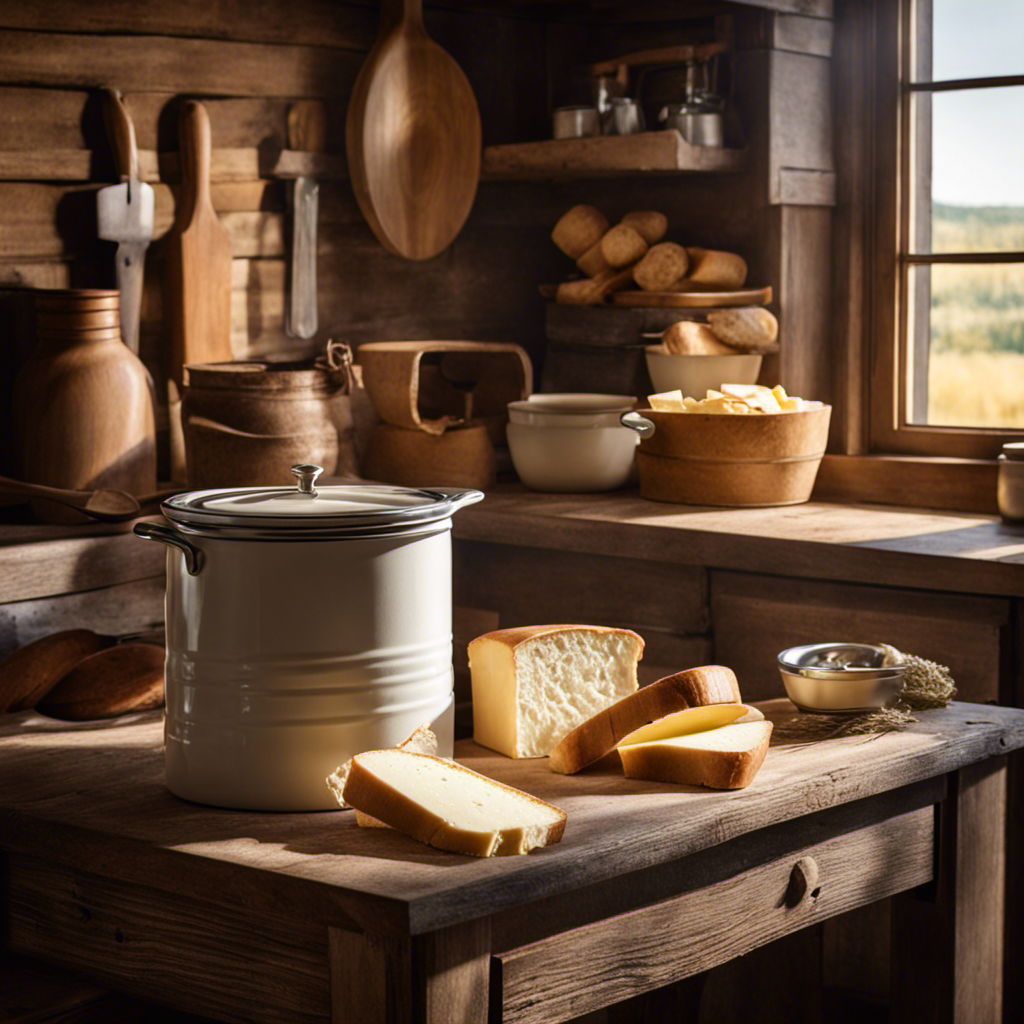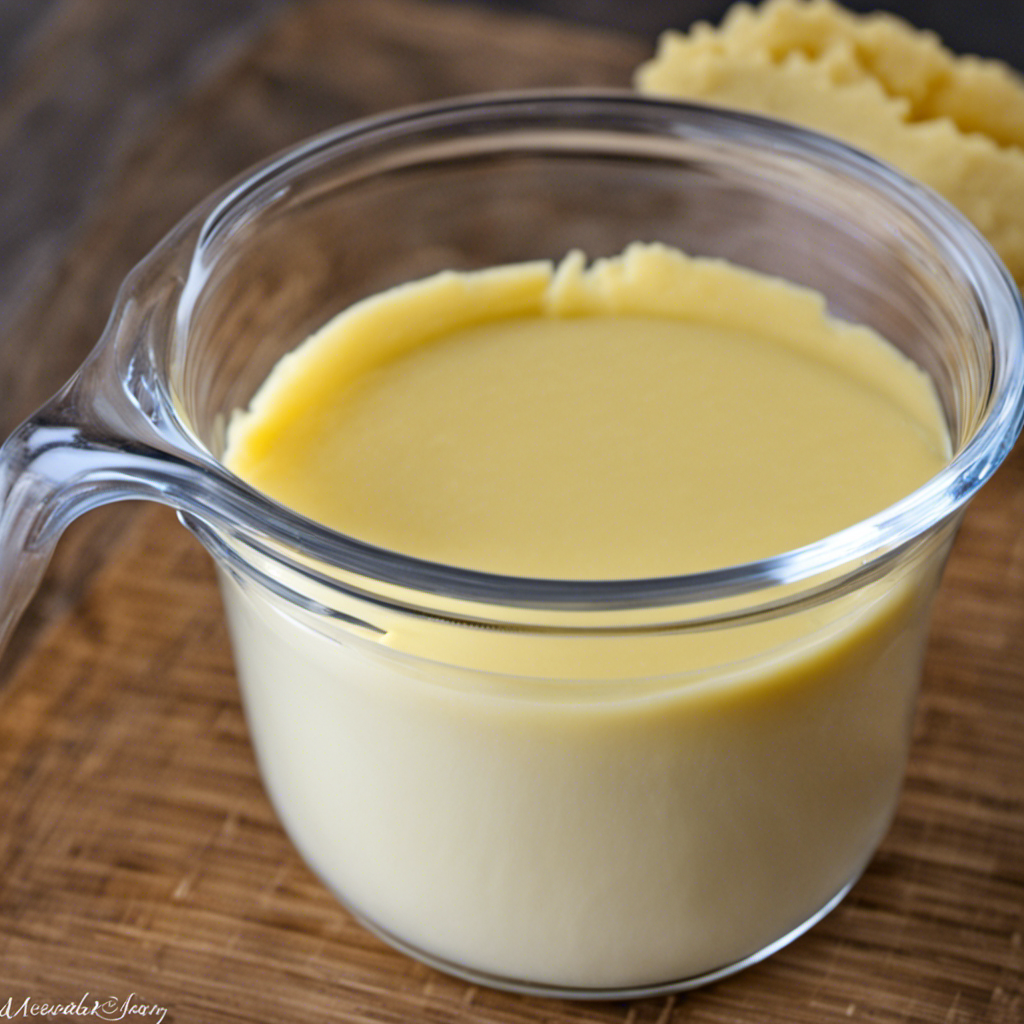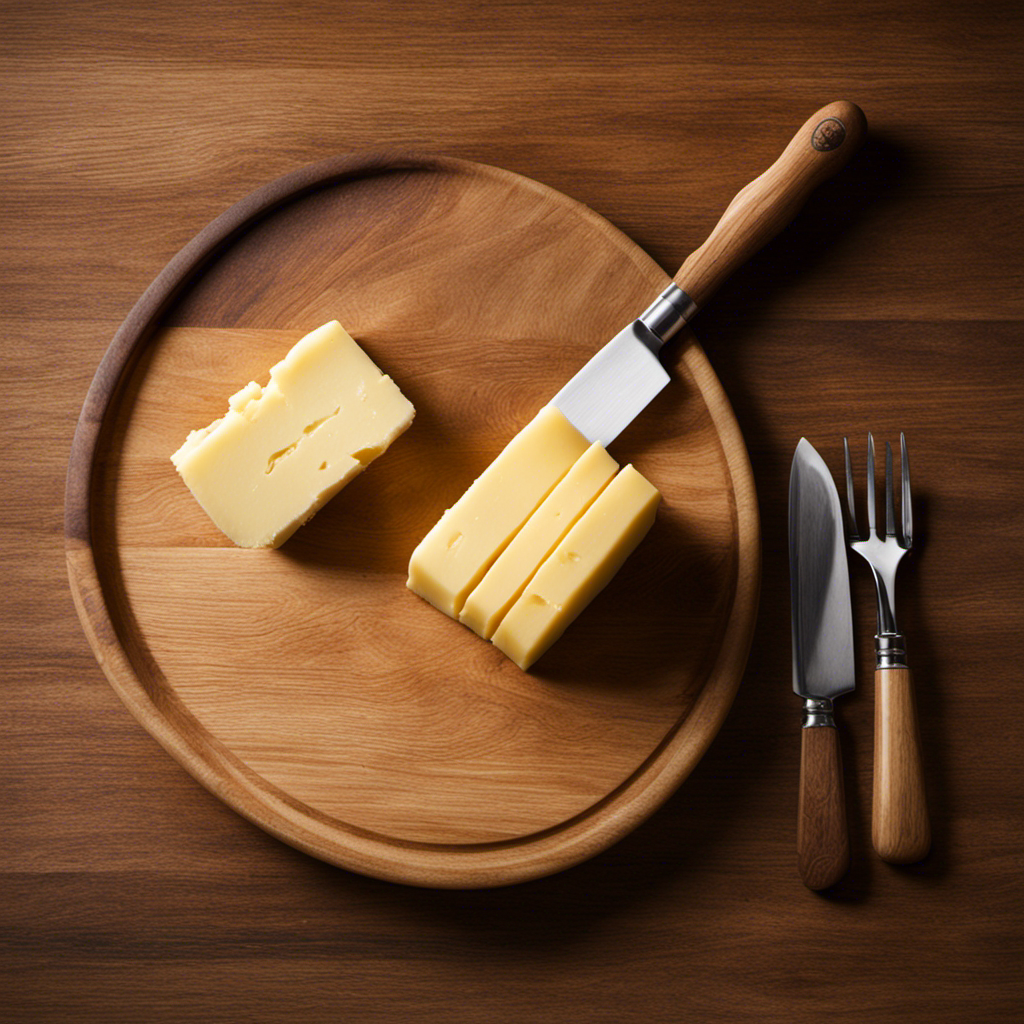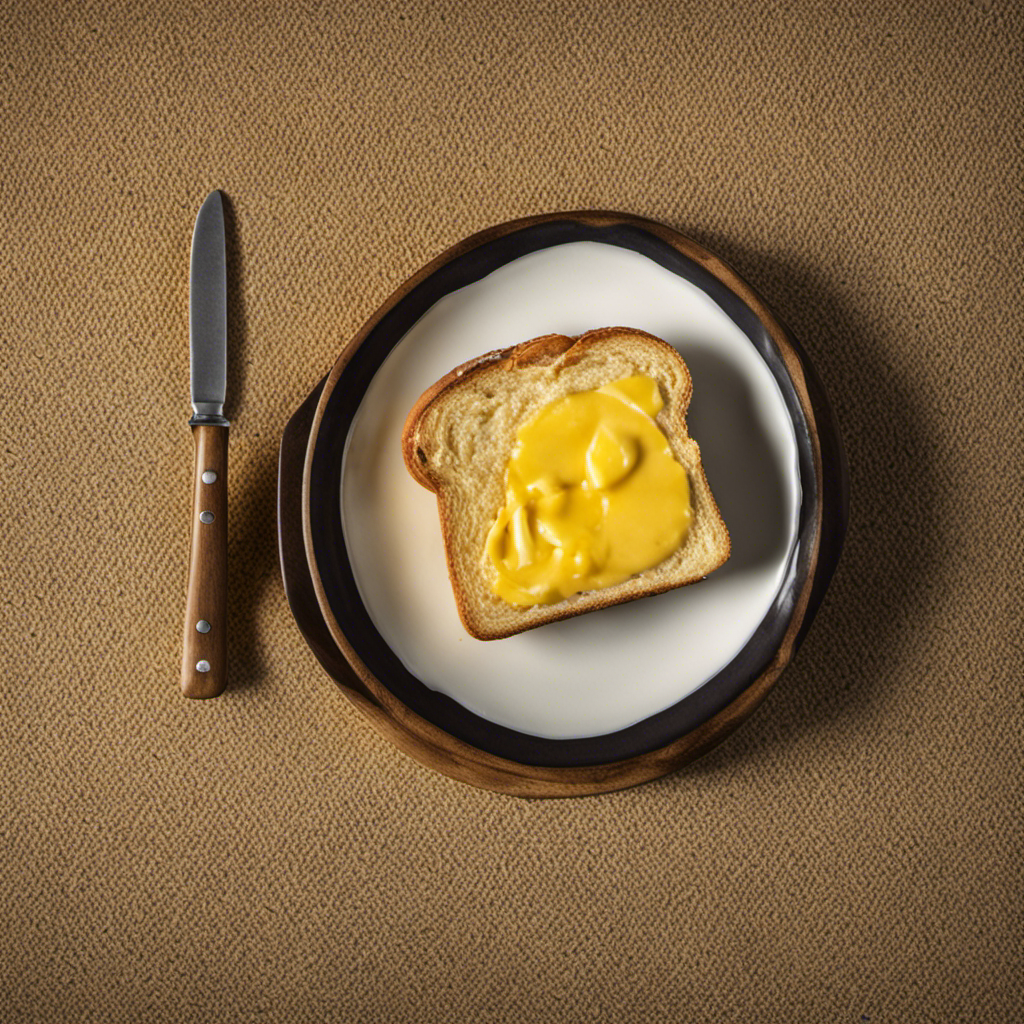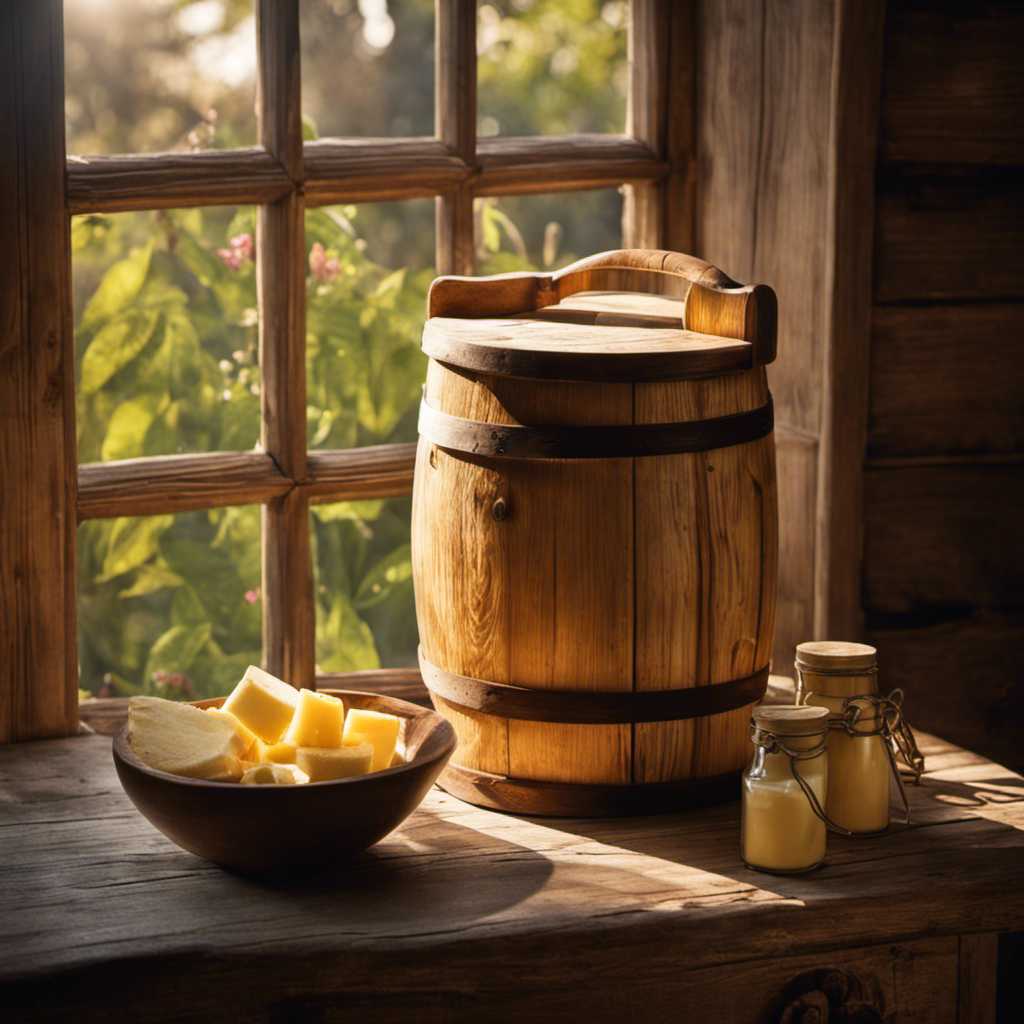Picture having perfectly smooth and spreadable butter at your disposal, each day. Using a butter crock makes this dream come true.
In this article, I’ll guide you through the simple steps to master the art of using a butter crock. From selecting the right crock to troubleshooting common issues, you’ll become a butter crock pro in no time.
So, grab your metaphorical butter knife and let’s dive into the wonderful world of butter crocks!
Key Takeaways
- Choose a butter crock made of ceramic, porcelain, or stoneware.
- Soften the butter before putting it in the crock by leaving it at room temperature for about 30 minutes.
- Clean the crock thoroughly after each use to prevent residue buildup.
- Store the butter crock in a cool and dry place to maintain quality and freshness.
Selecting the Right Butter Crock
When selecting the right butter crock, it’s important to consider the size that best suits your needs. Butter crocks come in various sizes, so it’s crucial to choose one that can hold an adequate amount of butter for your household.
If you have a smaller family or only use butter occasionally, a smaller-sized crock would be ideal. On the other hand, if you have a larger family or use butter frequently, a larger-sized crock would be more suitable.
Additionally, when selecting a butter crock, consider the materials it is made of. Common options include ceramic, porcelain, and stoneware. Each material has its own benefits, such as better insulation or a more aesthetically pleasing appearance.
Ultimately, selecting the right butter crock size and materials will ensure a convenient and enjoyable butter storage experience.
Preparing the Butter for the Crock
Before putting the butter in the crock, make sure it is soft and spreadable. This is important because a hard, cold stick of butter will not fit properly in the crock and will be difficult to spread. To achieve the perfect consistency, leave the butter out at room temperature for about 30 minutes before using. Alternatively, you can use a butter bell or butter keeper, which is specifically designed to keep butter soft and spreadable without the need for refrigeration. These handy kitchen gadgets come in various styles and sizes, making it easy to find one that suits your taste and decor. In addition to using a butter crock for storing butter, there are other alternative uses as well. You can use it to store small amounts of herbs or spices, or even as a cute and functional container for holding small kitchen utensils. The possibilities are endless!
| Pros | Cons |
|---|---|
| Keeps butter soft and spreadable | Requires regular butter maintenance |
| Adds a decorative touch to the kitchen | Limited storage capacity |
| Can be used for other purposes | Not suitable for larger quantities of butter |
| Helps reduce waste by eliminating the need for plastic wrap or foil | Requires hand-washing and drying |
Properly Storing Butter in the Crock
To properly store your butter in the crock, make sure it is soft and spreadable. This will ensure that the butter will easily fit into the crock and be ready for use whenever you need it.
Using a butter crock has several advantages over other butter storage methods. Firstly, it keeps the butter at the perfect temperature for spreading, allowing you to enjoy perfectly softened butter every time.
Secondly, it helps to preserve the freshness and flavor of the butter, ensuring that it stays delicious for longer periods.
Lastly, a butter crock adds a touch of elegance and charm to your kitchen, making it a beautiful addition to your countertop.
Now, let’s move on to how to use the butter crock to soften butter.
Using the Butter Crock to Soften Butter
The best way to soften your butter in the crock is by leaving it at room temperature for a few hours. This allows the butter to gradually soften without melting completely. Once the butter is soft, it becomes easier to spread on bread or use in recipes.
It is important to note that butter crock maintenance is essential for optimal performance. After each use, make sure to clean the crock thoroughly to prevent any residue buildup. Additionally, it is recommended to store the butter crock in a cool and dry place to maintain its quality and freshness.
When it comes to choosing the best butter crock brands, look for ones that are made of high-quality materials and have a tight-fitting lid to prevent air exposure. Some popular brands include Le Creuset, Sweese, and Norpro.
Cleaning and Maintaining the Butter Crock
When it comes to keeping my butter crock in top shape, there are a few key points to keep in mind.
First, using proper cleaning methods is essential to ensure the longevity of the crock.
Second, preventing mold growth is crucial for maintaining the quality of the butter.
Lastly, understanding the factors that contribute to the crock’s longevity will help me enjoy its benefits for years to come.
Let’s dive into these topics and learn how to properly clean and maintain our butter crocks.
Proper Cleaning Methods
Make sure you’re using a gentle sponge or cloth to clean your butter crock, so you don’t scratch the surface. Cleaning a butter crock is important to maintain its functionality and hygiene. Here are some effective cleaning techniques to remove stubborn stains:
-
Vinegar and Baking Soda: Create a paste using vinegar and baking soda, and apply it to the stained areas. Let it sit for a few minutes, then scrub gently with a sponge or cloth.
-
Lemon Juice: Squeeze some fresh lemon juice onto the stains and let it sit for a while. The acidity of the lemon will help break down the stains, making them easier to remove.
-
Salt Scrub: Mix salt with a little water to create a paste. Apply the paste to the stains and scrub gently in circular motions.
Longevity of Butter Crock
After learning about proper cleaning methods for my butter crock, I started wondering about its longevity. How can I ensure that my butter crock lasts for a long time? Well, the key is in maintaining it properly. By following a few simple steps, I can ensure the longevity of my butter crock. First, I should always handle it with care to prevent any accidental damage. Second, I should regularly check for any cracks or chips and replace it if necessary. Lastly, I should store it in a cool and dry place to prevent any moisture damage. By taking these precautions, I can enjoy using my butter crock for years to come.
| Tips for Longevity of Butter Crock |
|---|
| Handle with care |
| Regularly check for cracks or chips |
| Store in a cool and dry place |
Preventing Mold Growth
To prevent mold growth, it’s important to keep the butter crock clean and dry. Mold can ruin the taste and quality of your butter, so it’s crucial to take proper precautions.
Here are some mold prevention techniques and troubleshooting tips:
- Regularly clean the butter crock with warm, soapy water to remove any residue or bacteria.
- Ensure that the crock is completely dry before adding fresh butter to prevent moisture buildup.
- Store the butter crock in a cool, dry place away from direct sunlight.
By following these simple steps, you can maintain a mold-free butter crock and enjoy delicious, fresh butter every time.
If you’re experiencing mold issues despite these efforts, it may be helpful to consult a professional or consider using a different storage method. Remember, mold prevention is key to preserving the quality and taste of your butter.
Troubleshooting Common Butter Crock Issues
When it comes to butter, there are a few important factors to consider to ensure its freshness and quality.
In this discussion, we will explore effective mold prevention techniques, achieving the perfect softened butter consistency, and the importance of storing butter at the proper temperature.
Mold Prevention Techniques
For mold prevention techniques, make sure you are regularly changing the water in the butter crock. Mold can quickly develop in stagnant water, leading to spoilage of your butter.
To further prevent spoilage and extend the shelf life of your butter, consider using natural preservatives. Here are three options that not only help in preventing spoilage but also add flavor to your butter:
-
Sea salt: Sprinkle a pinch of sea salt into the water before placing the butter in the crock. This acts as a natural preservative and enhances the taste of the butter.
-
Herbs: Add fresh herbs like rosemary, thyme, or basil to the water. Not only do they provide a delightful aroma, but they also have antimicrobial properties that can inhibit mold growth.
-
Citrus zest: Grate some lemon or orange zest and mix it into the water. The natural oils in the zest act as a preservative and impart a refreshing citrus flavor to the butter.
Softened Butter Consistency
Achieving the perfect consistency for softened butter is easier than you might think. When it comes to maintaining a butter crock, it’s important to understand the key steps in achieving a spreadable consistency.
First, make sure your butter is at room temperature. This allows it to soften naturally and evenly.
Next, give your butter crock a quick rinse and dry it thoroughly. This helps to prevent any lingering flavors or odors from affecting the taste of your butter.
Then, simply place the softened butter into the crock and seal it tightly. The crock will keep the butter at the ideal consistency, ready to spread on your favorite bread or toast.
With proper butter crock maintenance and a little patience, you’ll always have perfectly softened butter at your fingertips.
Proper Storage Temperature
When it comes to preserving butter in a butter crock, maintaining the optimal temperature is essential. The ideal temperature for butter preservation is around 65 to 70 degrees Fahrenheit. This allows the butter to stay soft and spreadable without becoming too warm or melting.
Here are a few reasons why proper storage temperature is important for your butter crock:
- Keeps the butter at the perfect consistency for easy spreading.
- Prevents the butter from becoming too soft or melting, ensuring it stays fresh.
- Preserves the flavor and texture of the butter, enhancing your culinary experience.
By storing your butter crock at the optimal temperature, you can enjoy perfectly spreadable butter whenever you need it.
Now, let’s move on to some tips and tricks for maximizing the use of your butter crock.
Tips and Tricks for Maximizing the Use of Your Butter Crock
To make the most of your butter crock, try these helpful tips and tricks.
Maintaining your butter crock is essential to ensure its longevity and functionality. After each use, make sure to clean the crock thoroughly with warm soapy water to remove any leftover butter residue. It’s also a good idea to periodically check the seal of the crock to ensure it is still tight and effective.
If you find that your butter crock is no longer working or you’re looking for alternatives, there are a few options to consider. Butter bells, for example, are similar to butter crocks and function in a similar way. Another alternative is using a covered butter dish, which can also keep your butter fresh and spreadable.
Frequently Asked Questions
Can I Use My Butter Crock for Storing Other Types of Spreads, Such as Margarine or Cream Cheese?
No, a butter crock is specifically designed for storing butter. It helps keep the butter fresh and spreadable. Using margarine or cream cheese in a butter crock may not have the same benefits or results.
Can I Leave My Butter Crock Out on the Countertop or Does It Need to Be Refrigerated?
I can leave my butter crock out on the countertop! It doesn’t need to be refrigerated. It’s so convenient to have easy access to soft, spreadable butter anytime I want.
How Long Does Butter Stay Fresh in a Butter Crock?
Butter stays fresh in a butter crock for about a week. To properly clean a butter crock, wash it with warm, soapy water and dry thoroughly. When choosing the right size, consider how much butter you use regularly.
Is It Safe to Microwave Butter That Has Been Stored in a Butter Crock?
Microwaving butter stored in a butter crock is safe. The butter crock keeps the butter fresh and spreadable, so it’s ready to use whenever you need it. Just be sure to remove any wrapping before microwaving.
Can I Use a Butter Crock to Store Salted Butter?
Yes, I can use a butter crock to store salted butter. Using a butter crock for unsalted butter has many benefits, such as keeping it fresh, spreadable, and free from odors.
Conclusion
In conclusion, using a butter crock is a simple yet effective way to store and soften butter. By selecting the right crock and properly preparing and storing the butter, you can ensure that it stays fresh and spreadable for longer periods of time.
The crock’s unique design allows for easy access to softened butter whenever you need it, making it a convenient tool in the kitchen.
Remember to clean and maintain your crock regularly to ensure its longevity.
So go ahead, embrace the butter crock and elevate your butter experience to a whole new level of convenience and deliciousness!
